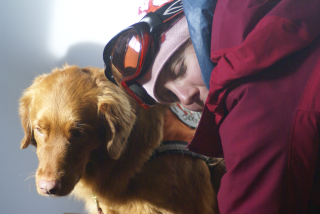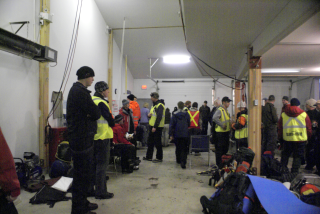
Rescue workers prepare to enter the avalanche site.

Jen Coulter and her avalanche search dog Farley after a hard day.

Volunteers gather at the Fernie and District Rescue Hall on Highway 3.
Fernie and District Search and Rescue president Chris Thomas was just arriving home at 2.41 p.m. on Sunday, Dec. 28 when the team's emergency cell phone rang.
His wife Sharron watched from the window as he ran into the house, and immediately took on her role as dispatcher for the volunteer team, beginning the call out of a few key members. Chris called the Provincial Emergency Program for permission to scramble a rescue helicopter once the distance to the location had been identified.
As countless news reports have told this week, the call was triggered by snowmobiler Kurt Kabel one hour earlier.
When he and three friends came across seven other sledders stuck in an avalanche Kabel pressed the emergency button on his new satellite personal tracker (spot) device, given to him by his wife for Christmas.
Minutes later Kabel and the ten other Sparwood men were engulfed in a second avalanche, killing eight and leaving only three survivors.
The hand held machine sent a GPS location signal up above the mountains to a satellite, bouncing back to a Texas call center who alerted the Elk Valley RCMP and triggered the largest avalanche search operation in Fernie and District Search and Rescue's history.
Over the next 48 hours, a total of 130 team members, volunteers from local backcountry groups and RCMP officers would rescue the three surviving members of the two groups, and search and recover the eight snowmobilers buried under several meters of snow.
For Search Manager Chris Thomas at that moment, though, the spot device was giving few clues as to what the team faced.
"They are new and all the 911 signal on it does is send a location and indicate that you need help. There is no way to say what type of help you need. "Family had told the RCMP there were four people in Kabel's group. We looked at a map and based on the terrain, were concerned that it might be an avalanche"
By luck Bighorn Helicopters had a chopper free and within 40 minutes Team Leader Simon Piney and three SAR members with avalanche and first aid skills were in the air.
"In the past it has taken up to an hour and a half to track a helicopter down," says Thomas. "It would be a mistake to think we have a helicopter waiting at our beck and call."
The flight to the Harvey Creek area 38km south east of Fernie took 25 minutes, but the team had to circle several times because there were so many sled tracks and the GPS location - set at the place where Kabel first saw the victims of the first avalanche - was away from the group's final resting place.
"The only thing we eventually saw was tracks and then the tip of a sled ski," says Piney "We could see the three guys' tracks so we flew down the road until we saw them and landed in front of them. I ran down to them and that was when they told me there were eight others buried."
The survivors - Jeff Adams, Jeremy Rusnak and James Drake - were in rough shape having lost their jackets, toques and safety gear in the avalanches before walking 5km from the site.
They were also in shock — having made what Adams later described as a "gut-wrenching decision" to leave their eight friends buried - and injured, Drake with a dislocated shoulder and Rusnak coughing up blood.
Three of the rescue team members were left on the ground while the helicopter took Piney and the three survivors to the intersection of Lodgepole Road and Ramcreek Road where the snowmobilers had parked their trucks.
The spot would later become the search staging area from which the helicopters could land and take off without disturbing the search site.
Even as the helicopter landed friends of Kabel were already arriving in the backcountry alerted by the spot device which also sends text alerts to pre-set numbers when it is activated, alarming the team members that a makeshift rescue could put others in danger. Road blocks were set up around the area by the RCMP.
The helicopter went back to pick up the team members. Two flew with Adams and Drake to Elk Valley Hospital, Piney and one SAR member driving Jeremy Rusnak to hospital by road.
Back at the search hall on Highway 3, the team had decided that, with avalanche risk still high and daylight fading fast, they could not risk further searches that night.
Instead they began planning the next day's search and rescue operation - as news wires across Canada began to report that eight men were lost.
The team has two Search Managers - Chris Thomas and Neil McDermid - and they are usually used independently so that there is one resting, and also available for other incidents that could occur during any particular rescue. In this case, both were used simultaneously due to the sheer size and complexity of the operation.
Offers of help began rolling in - Overwaitea opened early for the team to get food supplies; Tim Hortons sent over industrial-sized orders of coffee and Canadian Tire and Home Hardware Building Center supplied additional shovels and snowshoes.
Over the next two days even more donations arrived - 30 pizzas from Elk Valley Pizza; boxes of baked goods from a grateful Sparwood resident; and equipment and staff from outdoor adventures companies across the area.
Fernie Alpine Resort supplied explosives to avalanche technicians who returned to the site at 8 a.m. on Monday and Tuesday to make the area safe for rescue teams by triggering numerous avalanches on nearby slopes, each large enough to bury a car.
Kim Sedrovic of Fernie Wilderness Adventures used his snow cats to plough a road all the way from Morrissey to the avalanche site and build helicopter landing zones, giving a safe access route by snowmobile, meaning many more people could more easily take part in the search.
Piney and Thomas describe the location of the avalanche as being similar to the Lizard Bowl at Fernie Alpine Resort - on the right hand side a sheer rock face and on the left a shallower slope where the avalanche began, covering an area approximately 200ft wide and 500-600ft long.
"It wasn't an extremely steep slope," says Thomas. "It was a very low angle avalanche and I can see how they maybe got lulled into a false sense of security."
The RCMP dog team were first on the scene, flown in by helicopter to search for any scent of the men.
The next group sent in were nine search and rescue members who work as patrollers for Powder Cowboy Tours and Fernie Wilderness Adventures and three others with solid search and rescue skills.
They found the first body at 1 p.m. and by 2.30 p.m. had pulled six of the men out of snow up to 3 meters deep. A seventh body was found at 3.30p.m. just before the team prepared to leave before nightfall.
Only three of the men were found using their beacon - it is believed some had switched it to receive as they searched for buried friends after the first avalanche.
One body was located by the search dogs and the rest were found by searchers in probe lines. Looking for natural dips and obstacles such as trees teams of 6-8 walked in lines one step at a time, using 3.2m long probes to push down through the snow - once straight down, once on an angle to the left and once to the right.
Thomas says the avalanche must have been unusually slow. Most faster slides generate heat and cause the snow to harden like concrete, whereas this snow was soft and easy to dig through, helping them find the victims so quickly. Even then, up to 60 people worked on the site at a time, digging methodically and swapping regularly to prevent fatigue.
As darkness fell on Monday and with the body of Danny Bjarnason still missing, a group of search and rescue members and RCMP stayed at the staging area overnight to keep watch.
The next morning survivor Jeff Adams returned to the site to show them where he last saw his friend, giving them a narrower area to search. Search dogs had also been pointing to that area but, in the end, it was a team member randomly pushing his probe into the ground who found the final victim's body at 11.38 a.m.
"From a search and rescue perspective it is extremely relieving to have completed the search, because of the number of rescue personnel you have in a dangerous place," says Piney.
Thomas says from an emotional point of view he like many members found it hard to deal with the scale of the tragedy so close to home. `
"I have dealt with other avalanche deaths but this one was a lot harder to detach yourself from," he said.
"The sheer number of bodies to deal with means we exposed many more of our members to very difficult situations both at the site and at the staging area where the bodies were taken by helicopter."
"We will have debriefings and counseling is available to all search and rescue members and volunteers who came to help us."
The team say they were overwhelmed by the support they received from across the Elk Valley and B.C.
"There was an amazing sense of community - there were so many people who did not need to do anything but who came forward and did all they could," said Piney
He added: "The nature of the event was very tragic but also very reassuring that we have search and rescue capabilities on that scale."
Anyone who worked on the search can receive advice or counseling from the BC Search and Rescue Association at 1-800-663-3456. Support is also available from Worksafe BC - call Jeff McKay at 1-800-663-4962.
